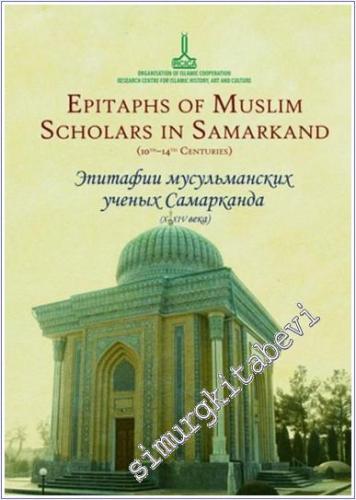#smrgKİTABEVİ Epitaphs of Muslim Scholars in Samarkand: 10th - 14th Centuries - 2019

Project Director: Prof. Halit Eren; indexes, glossary, illustrations by Urkiya Utepbergenova, Aitzhan Nurmanova
appendix by Amriddin Berdimuradov; photos by Akhror Mukhtarov, Lola Dodkhudoeva, Bakhtiyar Babadjanov
IRCICA, 2019 (Sources and studies on the history of Islamic civilization; no. 39). – 652 p.
Text in Russian, with some texts in English and Arabic.
Epitaphs of Muslim Scholars in Samarkand (10th–14th Centuries)
The book contains texts in Arabic script of 239 epitaphs of Central Asian scholars who lived from the 10th to 14th centuries with their representations, translations into Russian and commentaries. It includes an introductory article, detailed scholarly indices, a glossary, bibliography, and other illustrations.
The published materials are original sources for the study of the politics of religion under the Qarakhanid Dynasty (992–1211), for the mechanism of cooperation between the power and religion, and for the role of Islamic scholars in mediating between the authorities and the public.
The publication will benefit researchers in religious studies, Islamic studies, anthropology, history, and all those interested in the evolution of the traditional Islam in Central Asia.
Project Director: Prof. Halit Eren; indexes, glossary, illustrations by Urkiya Utepbergenova, Aitzhan Nurmanova
appendix by Amriddin Berdimuradov; photos by Akhror Mukhtarov, Lola Dodkhudoeva, Bakhtiyar Babadjanov
IRCICA, 2019 (Sources and studies on the history of Islamic civilization; no. 39). – 652 p.
Text in Russian, with some texts in English and Arabic.
Epitaphs of Muslim Scholars in Samarkand (10th–14th Centuries)
The book contains texts in Arabic script of 239 epitaphs of Central Asian scholars who lived from the 10th to 14th centuries with their representations, translations into Russian and commentaries. It includes an introductory article, detailed scholarly indices, a glossary, bibliography, and other illustrations.
The published materials are original sources for the study of the politics of religion under the Qarakhanid Dynasty (992–1211), for the mechanism of cooperation between the power and religion, and for the role of Islamic scholars in mediating between the authorities and the public.
The publication will benefit researchers in religious studies, Islamic studies, anthropology, history, and all those interested in the evolution of the traditional Islam in Central Asia.





















